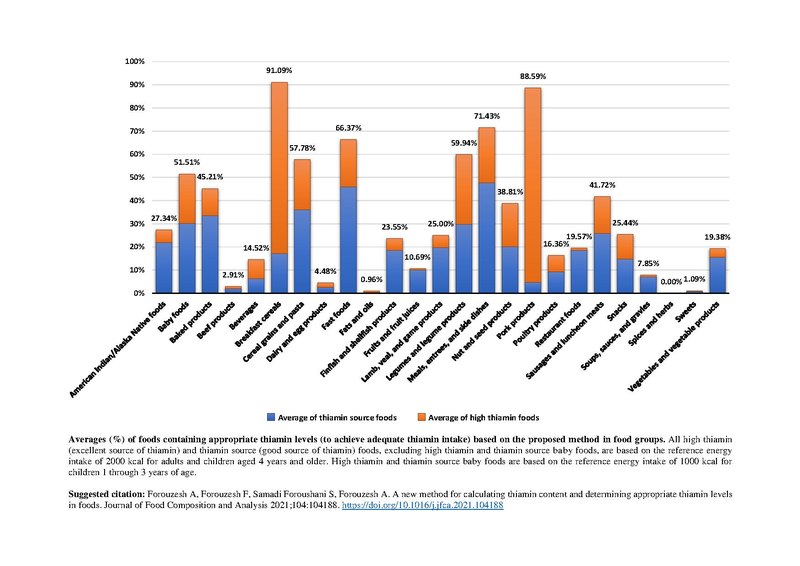File:Averages (%) of foods containing appropriate thiamin levels (to achieve adequate thiamin intake) in food groups.pdf

Original file (1,752 × 1,239 pixels, file size: 413 KB, MIME type: application/pdf)
Captions
Captions
Summary[edit]
| DescriptionAverages (%) of foods containing appropriate thiamin levels (to achieve adequate thiamin intake) in food groups.pdf |
English: Averages (%) of foods containing appropriate thiamin levels (to achieve adequate thiamin intake) based on the proposed method in food groups. All high thiamin (excellent source of thiamin) and thiamin source (good source of thiamin) foods, excluding high thiamin and thiamin source baby foods, are based on the reference energy intake of 2000 kcal for adults and children aged 4 years and older. High thiamin and thiamin source baby foods are based on the reference energy intake of 1000 kcal for children 1 through 3 years of age.
About 95.6 % of foods contained thiamin. On the basis of the proposed method, the average (%) of foods containing appropriate thiamin levels in food groups was 32.46 %, of which 17.54 % was the average of thiamin source (good source of thiamin) foods, and 14.92 % was the average of high thiamin (excellent source of thiamin) foods. Breakfast cereals with 91.09 %, pork products with 88.59 %, meals, entrees, and side dishes with 71.43 %, fast foods with 66.37 %, legumes and legume products with 59.94 %, cereal grains and pasta with 57.78 %, baby foods with 51.51 %, baked products with 45.21 %, sausages and luncheon meats with 41.72 %, and nut and seed products with 38.81 % had the highest averages of foods containing appropriate thiamin levels. Most foods containing appropriate thiamin levels in 10 food groups (baby foods; baked products; beverages; breakfast cereals; cereal grains and pasta; fast foods; fats and oils; meals, entrees, and side dishes; restaurant foods; snacks) were allocated to thiamin-fortified foods. Foods containing appropriate thiamin levels were not found in one food group (spices and herbs) and were very few in five food groups (fats and oils; sweets; beef products; dairy and egg products; soups, sauces, and gravies). Suggested citation: Forouzesh, Abed; Forouzesh, Fatemeh; Samadi Foroushani, Sadegh; Forouzesh, Abolfazl. A new method for calculating thiamin content and determining appropriate thiamin levels in foods. Journal of Food Composition and Analysis 2021;104:104188. https://doi.org/10.1016/j.jfca.2021.104188 |
| Date | |
| Source | Own work |
| Author | SSamadi15 |
Licensing[edit]
- You are free:
- to share – to copy, distribute and transmit the work
- to remix – to adapt the work
- Under the following conditions:
- attribution – You must give appropriate credit, provide a link to the license, and indicate if changes were made. You may do so in any reasonable manner, but not in any way that suggests the licensor endorses you or your use.
- share alike – If you remix, transform, or build upon the material, you must distribute your contributions under the same or compatible license as the original.
File history
Click on a date/time to view the file as it appeared at that time.
| Date/Time | Thumbnail | Dimensions | User | Comment | |
|---|---|---|---|---|---|
| current | 14:46, 13 October 2021 |  | 1,752 × 1,239 (413 KB) | SSamadi15 (talk | contribs) | Uploaded own work with UploadWizard |
You cannot overwrite this file.
File usage on Commons
There are no pages that use this file.
Metadata
This file contains additional information such as Exif metadata which may have been added by the digital camera, scanner, or software program used to create or digitize it. If the file has been modified from its original state, some details such as the timestamp may not fully reflect those of the original file. The timestamp is only as accurate as the clock in the camera, and it may be completely wrong.
| Author | Sadegh Samadi |
|---|---|
| Software used | Microsoft® Word LTSC |
| Date and time of digitizing | 02:27, 10 October 2021 |
| File change date and time | 02:27, 10 October 2021 |
| Conversion program | Microsoft® Word LTSC |
| Encrypted | no |
| Page size | 841.92 x 595.32 pts (A4) |
| Version of PDF format | 1.7 |